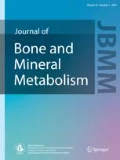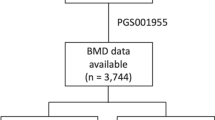Abstract
A genetic risk score (GRS) was developed for predicting fracture risk based on lifetime prevalence of femoral fractures in 924 consecutive autopsies of Japanese males. A total of 922 non-synonymous single nucleotide polymorphisms (SNPs) located in 62 osteoporosis susceptibility genes were genotyped and evaluated for their association with the prevalence of femoral fracture in autopsy cases. GRS values were calculated as the sum of risk allele counts (unweighted GRS) or the sum of weighted scores estimated from logistic regression coefficients (weighted GRS). Five SNPs (α-ʟ-iduronidase rs3755955, C7orf58 rs190543052, homeobox C4 rs75256744, G patch domain-containing gene 1 rs2287679, and Werner syndrome rs2230009) showed a significant association (P < 0.05) with the prevalence of femoral fracture in 924 male subjects. Both the unweighted and weighted GRS adequately predicted fracture prevalence; areas under receiver-operating characteristic curves were 0.750 [95 % confidence interval (CI) 0.660–0.840] and 0.770 (95 % CI 0.681–0.859), respectively. Multiple logistic regression analysis revealed that the odds ratio (OR) for the association between fracture prevalence and unweighted GRS ≥3 (n = 124) was 8.39 (95 % CI 4.22–16.69, P < 0.001) relative to a score <3 (n = 797). Likewise, the OR for a weighted GRS of 6–15 (n = 135) was 7.73 (95 % CI 3.89–15.36, P < 0.001) relative to scores of 0–5 (n = 786). The GRS based on risk allele profiles of the five SNPs could help identify at-risk individuals and enable implementation of preventive measures for femoral fracture.

Similar content being viewed by others
References
Reginster JY, Burlet N (2006) Osteoporosis: a still increasing prevalence. Bone 38:S4–S9
Soen S, Fukunaga M, Sugimoto T, Sone T, Fujiwara S, Endo N, Gorai I, Shiraki M, Hagino H, Hosoi T, Ohta H, Yoneda T, Tomomitsu T (2013) Diagnostic criteria for primary osteoporosis: year 2012 revision. J Bone Miner Metab 31:247–257
Peacock M, Turner CH, Econs MJ, Foroud T (2002) Genetics of osteoporosis. Endocr Rev 23:303–326
Ralston SH, Uitterlinden AG (2010) Genetics of osteoporosis. Endocr Rev 31:629–662
Styrkarsdottir U, Halldorsson BV, Gretarsdottir S, Gudbjartsson DF, Walters GB, Ingvarsson T, Jonsdottir T, Saemundsdottir J, Center JR, Nguyen TV, Bagger Y, Gulcher JR, Eisman JA, Christiansen C, Sigurdsson G, Kong A, Thorsteinsdottir U, Stefansson K (2008) Multiple genetic loci for bone mineral density and fractures. N Engl J Med 358:2355–2365
Rivadeneira F, Styrkarsdottir U, Estrada K, Halldórsson BV, Hsu YH, Genetic Factors for Osteoporosis (GEFOS) Consortium et al (2009) Twenty bone-mineral-density loci identified by large-scale meta-analysis of genome-wide association studies. Nat Genet 41:1199–1206
Estrada K, Styrkarsdottir U, Evangelou E, Hsu YH, Duncan EL et al (2012) Genome-wide meta-analysis identifies 56 bone mineral density loci and reveals 14 loci associated with risk of fracture. Nat Genet 44:491–501
ERICA Research Group (1991) Prediction of coronary heart disease in Europe: the 2nd report of the WHO-ERICA Project. Eur Heart J 12:291–297
Tunstall-Pedoe H (1991) The Dundee coronary risk-disk for management of change in risk factors. BMJ 303:744–747
Lindström J, Tuomilehto J (2003) The diabetes risk score: a practical tool to predict type 2 diabetes risk. Diabetes Care 26:725–731
Kivipelto M, Ngandu T, Laatikainen T, Winblad B, Soininen H, Tuomilehto J (2006) Risk score for the prediction of dementia risk in 20 years among middle aged people: a longitudinal, population-based study. Lancet Neurol 5:735–741
Grove ML, Yu B, Cochran BJ, Haritunians T, Bis JC et al (2013) Best practices and joint calling of the HumanExome BeadChip: the CHARGE Consortium. PLoS One 8:e68095
Piccolo SR, Abo RP, Allen-Brady K, Camp NJ, Knight S, Anderson JL, Horne BD (2009) Evaluation of genetic risk scores for lipid levels using genome-wide markers in the Framingham Heart Study. BMC Proc 15:S46
Reitz C, Tang MX, Schupf N, Manly JJ, Mayeux R, Luchsinger JA (2010) A summary risk score for the prediction of Alzheimer disease in elderly persons. Arch Neurol 67:835–841
Zhou H, Mori S, Tanaka M, Sawabe M, Arai T, Muramatsu M, Naka Mieno M, Shinkai S, Yamada Y, Miyachi M, Murakami H, Sanada K, Ito H (2015) A missense single nucleotide polymorphism, V114I of the Werner syndrome gene, is associated with risk of osteoporosis and femoral fracture in the Japanese population. J Bone Miner Metab (in press)
Youden WJ (1950) Index for rating diagnostic tests. Cancer 3:32–35
Duan Y, Beck TJ, Wang XF, Seeman E (2003) Structural and biomechanical basis of sexual dimorphism in femoral neck fragility has its origins in growth and aging. J Bone Miner Res 18:1766–1774
Karasik D, Ferrari SL (2008) Contribution of gender-specific genetic factors to osteoporosis risk. Ann Hum Genet 72:696–714
Bie H, Yin J, He X, Kermode AR, Goddard-Borger ED, Withers SG, James MN (2013) Insights into mucopolysaccharidosis I from the structure and action of α-l-iduronidase. Nat Chem Biol 9:739–745
Moayyeri AL, Hsu YH, Karasik D, Estrada K, Xiao SM et al (2014) Genetic determinants of heel bone properties: genome-wide association meta-analysis and replication in the GEFOS/GENOMOS consortium. Hum Mol Genet 23:3054–3068
Medina-Gomez C, Kemp JP, Estrada K, Eriksson J, Liu J et al (2012) Meta-analysis of genome-wide scans for total body BMD in children and adults reveals allelic heterogeneity and age-specific effects at the WNT16 locus. PLoS Genet 8:e1002718
Acknowledgments
This work was supported by a grant from the Leading Project for Personalized Medicine of the Ministry of Education, Culture, Sports, Science and Technology of Japan (no. 09042037 to S.M.); Grants-in-Aid for Scientific Research (nos. 22240072, 21390459, and 21590411 to M.T. and 18209023, 18018021, 19659149, and 24590746 to Y.Y.); a Grant-in-Aid for the Global COE (Sport Sciences for the Promotion of Active Life to Waseda University) from the Ministry of Education, Culture, Sports, Science and Technology of Japan (to M.T.); Grants-in-Aid for Research on Intractable Diseases (Mitochondrial Disease) from the Ministry of Health, Labour and Welfare of Japan (H23-016, H23-119, and H24-005 to M.T.); grants for scientific research from Mitsui Sumitomo Insurance Welfare Foundation (to S.M.); the Pfizer Academic Contribution Fund (to S.M.); Takeda Science Foundation (to M.T.); the Smoking Research Foundation (to T.A. and M.S.); and the Mie Medical Valley Project (to Y.Y.).
Author information
Authors and Affiliations
Corresponding author
Ethics declarations
Conflicts of interest
Heying Zhou, Seijiro Mori, Tatsuro Ishizaki, Masashi Tanaka, Kumpei Tanisawa, Makiko Naka Mieno, Motoji Sawabe, Tomio Arai, Masaaki Muramatsu, Yoshiji Yamada, and Hideki Ito declare that they have no conflicts of interest.
Electronic supplementary material
Below is the link to the electronic supplementary material.
About this article
Cite this article
Zhou, H., Mori, S., Ishizaki, T. et al. Genetic risk score based on the lifetime prevalence of femoral fracture in 924 consecutive autopsies of Japanese males. J Bone Miner Metab 34, 685–691 (2016). https://doi.org/10.1007/s00774-015-0718-7
Received:
Accepted:
Published:
Issue Date:
DOI: https://doi.org/10.1007/s00774-015-0718-7




